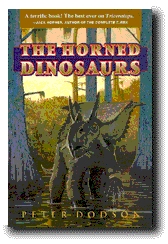The Horned Dinosaursby Peter Dodson |
 |
Reviewed by Robert Holmes
Ceratopsian dinosaurs have intrigued professional palaeontologists and the general public alike since the end of the last century, when bones of these creatures were first collected from the Cretaceous deposits of western North America. Early work, much by O. C. Marsh and his associates, culminated in a lavishly illustrated volume entitled The Ceratopsia (Hatcher, Marsh, and Lull 1907). A second contribution (Lull 1933) reported additional discoveries of the subsequent quarter-century, but despite the description of a number of new taxa since publication of the latter, no new reviews of the group have been attempted.
Peter Dodson's book, The Horned Dinosaurs, although not a scientific review in the traditional sense, nevertheless fills this void in many respects. The anatomy, systematics, and biology of the group are briefly covered. The history of collection is discussed, and all known taxa are described. New discoveries and reinterpretations of old data, as well as recent controversies surrounding these interesting beasts are explored. Each chapter is generously footnoted and well indexed. Since this volume is not intended first and foremost as a technical treatise, much of the "hard" data have been omitted, but the reader need not miss anything - Dodson has done an excellent job providing references to the primary literature if more information is desired. The volume is well illustrated with carefully chosen figures from the literature as well as many original figures by Robert Walters and several attractive coloured plates by Wayne Barlowe.
In Chapter 1, Dodson sets the stage with a overview of ceratopsian classification, introduces some basic concepts of systematics, and then gives a thumbnail sketch of the early history of field collection, in which he tips his hat to all the usual suspects and introduces a number of ceratopsians unfamiliar to all but the initiated. In Chapter 2, he covers the basics of ceratopsian anatomy, and in Chapter 3, uses an extended discussion of the most famous horned dinosaur, Triceratops, as a vehicle to deliver a brief history of the Cope-Marsh feud, and air a problem all too common in paleontology of the late ninteenth and early twentieth century paleontology - the artificial multiplication of species, or "splitting". With the reader now on firm ground, Dodson then delves into the two ceratopsid subfamilies: the Chasmosaurinae and Centrosaurinae. Each genus is introduced, described, and discussed in turn. This is followed by an account of current work and recently described taxa. A chapter on the basal protoceratopsids, which includes information on the obscure central Asian forms originally described in the often difficult to get Russian journals rounds out the discussion. Chapter 8 presents a history of ceratopsian classification and a comparison between recent cladistic and resistant-fit theta-rho analyses (fortunately producing similar results) are given. The final chapter explores the biology of ceratopsians-hypotheses regarding feeding, locomotion, social behavior, and possible causes of their extinction.
What sets this book apart is that it is fun to read. Dodson is very clear in the preface-this volume is a personal offering, and as a result it is infused with the enthusiasm (not to mention the occasional idiosyncracy) of the author. This not only provides an entertaining read, but proves to have considerable heuristic value. For example, in Chapter 2 "Skin and Bones", Dodson approaches the potentially dry topic of skeletal anatomy by concocting an amusing yarn at his own expense. We are presented with an image of Dodson sitting on his livingroom floor surrounded by a disarticulated cast of a Chasmosaurus skeleton purchased from Big Bob's Bargain Bone Barn. Lacking assembly instruction and desperate to clean up the mess before his wife returns home, he begins to sort the bones into piles. As we read on, we gradually realize that what he is actually doing is walking us through the anatomy step by step. Although arguably not necessary for fellow palaeontologists, this is very helpful to the nonspecialists who presumably represent a large percentage of the intended audience.
Dodson has attained a fine balance here. He has, on the one hand, written a book that can be read and understood by an intellegent, informed high school student, while providing enough substance to keep the attention and interest of other paleontologists.
REFERENCES
Hatcher, J.B., Marsh, O.C., and Lull, R.S., 1907. The Ceratopsia. United States Geological Survey Monograph 49, 1-300.
Lull, R.S., 1933. A revision of the Ceratopsia or horned dinosaurs. Peabody Museum of Natural History Memoirs 3: 1-175.
Copyright: Coquina Press
22 October 1999
http://palaeo-electronica.org

